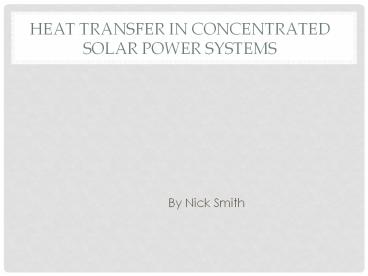Heat Transfer in Concentrated Solar Power Systems - PowerPoint PPT Presentation
Title:
Heat Transfer in Concentrated Solar Power Systems
Description:
HEAT TRANSFER IN CONCENTRATED SOLAR POWER SYSTEMS By Nick Smith INTRODUCTION Concentrating Solar Power Systems (CSPs) focus a large area of sunlight onto a small area. – PowerPoint PPT presentation
Number of Views:217
Avg rating:3.0/5.0
Title: Heat Transfer in Concentrated Solar Power Systems
1
Heat Transfer in Concentrated Solar Power Systems
- By Nick Smith
2
Introduction
- Concentrating Solar Power Systems (CSPs) focus a
large area of sunlight onto a small area. Unlike
photovoltaic systems, the sun's energy is not
directly converted to electricity. Instead it is
used to heat a fluid to steam, which in turn
powers a turbine.
3
Introduction (cont.)
- Parabolic Solar Trough Power Plant in Israel
4
Schematic Drawings
5
Objective
- Use a simplified Heat Transfer Approach to find
the optimum fluid, and length of the parabolic
trough.
6
Assumptions
- q is evenly distributed across the tubing
- Fluid enters tube at ambient temperature, 20C
- Effects of the tubing material are negligible
- To function properly, the average fluid
temperature at exit should be 400C
- Radiation from the sun can be approximated
(normalizing for the earth's surface area) as 680
W/m2 - Parabola perfectly reflects energy and can be
approximated as a semi-circle - Flow-rate is 0.2 kg/s
7
Approach
- The heat flux on the tube is equal to the solar
heat flux over a semi-circle of 2.5m diameter
8
Calculations
- A simple energy balance equation will now give us
the ideal length for each potential fluid
- Lengths of various materials, using average Cp
- Water 130 m
- Oil 71 m
- Mercury 3.85 m
9
Conclusions
- While Mercury would be the ideal material, it is
hazardous and expensive, so oil should be used,
as it is almost twice as efficient as water. More
precise calculations should be done using
different types of oil to find the most ideal
material, perhaps a mixture with mercury would
provide the best properties.
10
Appendix
- A more complete of heat transfer in CSP systems
is available here - http//pointfocus.com/images/pdfs/saltw-troughs.pd
f
- Pictures and drawings are courtesy of Andrew
Buck, modified by myself































